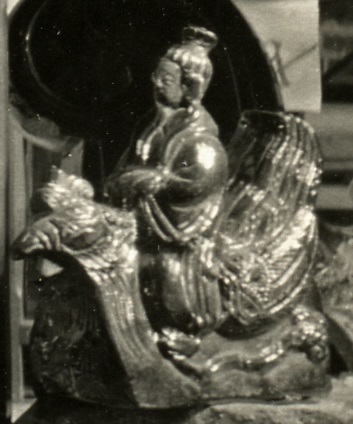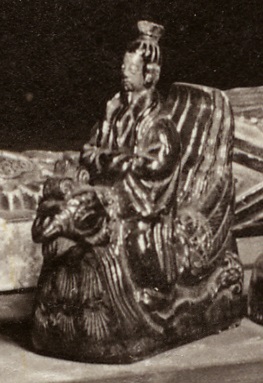Workshop: unknown, possibly from the vicinity of Beijing (Beijing) or Shenyang
Architectural detail; burnt clay; die imprinting, manual processing, glazing, firing.
Measurements: unknown
Provenance: China, Qing Dynasty, Kangxi Emperor Period (1644–1722).
The Acroterion with a figure of a Taoist monk sitting on a fenghuang bird came from a gift given in 1909 by Ernst Börschmann. Based on analogous examples, it can be assumed that the Malbork copy was about 29.5 cm high and was glazed in two colors: yellow in two shades, turquoise and brown. Colors were very symbolic in Chinese culture. The luminous, bright yellow color was called ginger yellow and became very fashionable during the Kangxi era. It was attributed to the emperor and Buddhist and Taoist monasteries. Black or brown with a shade of red was associated with mystery and magic. Only the turquoise (blue-green) color was devoid of symbolic meanings, but we know from the history of Chinese porcelain that glazes of such a color gained extraordinary popularity in the 18th century.
Chinese acroteria was placed on the top or ends of the main beam of the roof ridge and they were called the owl’s tail (Chinese: chiwei), fish tail (Chinese: yüwei), or dragon’s mouth (Chinese: longwen). The Malbork acroterion with a figure of a monk on a fenghuang bird (Polish: Chinese phoenix) presents the late editing of the myth about Laozi (Polish: Old Master). The legendary founder of Laozi Taoism was a symbol of longevity. He was depicted as an old man riding a water buffalo, but in the later myths of his successor, the so-called Immortals rode the wind and clouds, and the mythical fenghuang bird symbolized, among others, the wind. Often this bird was confused with a phoenix, rooster or an owl. However, its complicated structure was also reflected in the symbolism. Most often it was considered a sign assigned to the empress. With regard to the location, the Malbork acroterion can be classified as the so-called groups of owls tails.
Source: APM, ref. 206/549, pp. 214–222; MBj. 1908, photo 3; MBj 1910, photo 5.
(compiled by Dr. B. Pospieszna)


